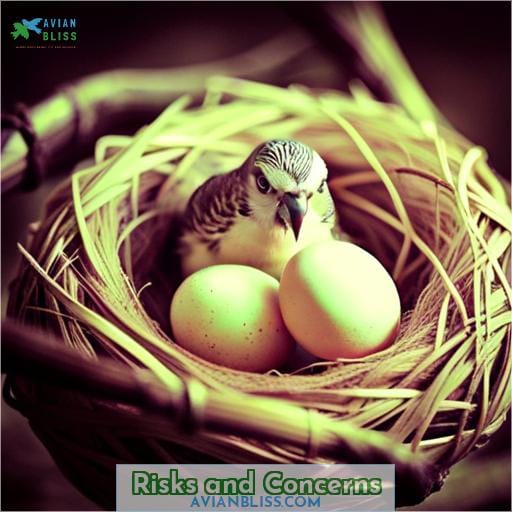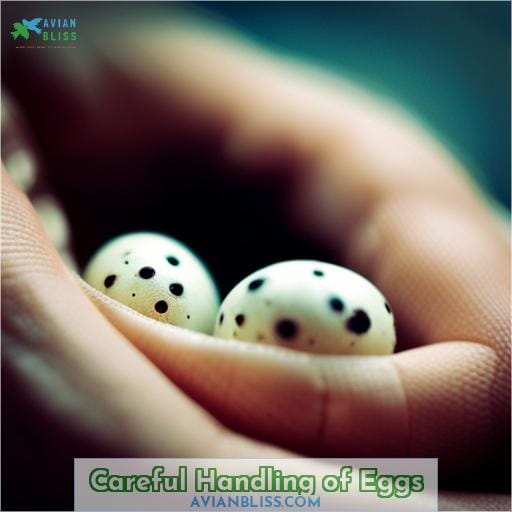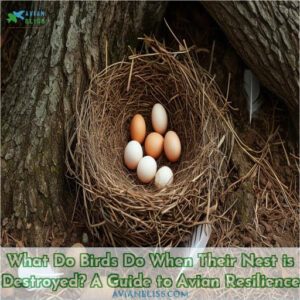This site is supported by our readers. We may earn a commission, at no cost to you, if you purchase through links.
 Imagine the delicate beauty of a budgie’s nest, filled with precious eggs just waiting to hatch.
Imagine the delicate beauty of a budgie’s nest, filled with precious eggs just waiting to hatch.
In this article, we will explore the opinions of experts and delve into the risks and concerns associated with moving budgie eggs. We’ll also provide guidance on careful handling techniques and discuss behavioral aspects that may affect your decision.
So let’s find out: can you safely move budgie eggs?
Table Of Contents
- Key Takeaways
- Opinions on Moving Budgie Eggs
- Risks and Concerns
- Careful Handling of Eggs
- Behavioral Aspects
- Frequently Asked Questions (FAQs)
- What are the potential risks or consequences of moving budgie eggs?
- How should budgie eggs be handled to minimize stress and potential damage?
- Can budgies successfully adopt and incubate another female’s eggs?
- Is it recommended to provide each female budgie with a separate nesting box?
- What factors should be considered before deciding to move budgie eggs?
- Conclusion
Key Takeaways
- Varying opinions exist among experts regarding the necessity of moving budgie eggs.
- Disturbing the mother during relocation may lead to nest abandonment.
- Budgie eggs are highly fragile and susceptible to cracking.
- Hen budgies may adopt and incubate unrelated eggs in social situations.
Opinions on Moving Budgie Eggs
As an experienced budgie breeder, you understand that opinions on moving budgie eggs can vary among experts in the field.
Some argue that moving eggs is necessary in high-traffic cage areas to ensure the safety and well-being of both the mother bird and her clutch. However, it’s important to consider factors such as the bird’s response and nesting habits before making a decision.
Ultimately, careful handling and consideration for potential risks are crucial when deciding whether or not to move budgie eggs.
Varying Opinions Among Experts
Opinions among experts regarding the safe movement of budgie eggs vary.
Some argue that moving eggs is necessary in high-traffic cage areas, while others caution against it due to the risk of abandonment by the mother.
Factors such as embryo health and fragility of budgie eggs also play a role in determining whether or not moving them is advisable.
It’s important to consider these perspectives before deciding on transferring budgie eggs for breeding purposes.
Considerations for Moving Eggs in High-traffic Cage Areas
When considering the possibility of moving budgie eggs in high-traffic cage areas, experts have varying opinions.
Some argue that it’s necessary to move the eggs for their safety and well-being, while others caution against it due to potential risks and disruptions.
Factors such as cage traffic, nesting challenges, egg health, and handling tips should be taken into account when making a decision.
It’s crucial to weigh these considerations carefully before deciding whether or not to move budgie eggs in high-traffic environments.
Risks and Concerns
Moving budgie eggs can pose several risks and concerns that need to be carefully considered.
Disturbing the mother during the process may lead to her abandoning the nest, leaving the eggs vulnerable.
Additionally, there’s a potential risk of causing harm or stress to the embryos if they aren’t handled properly during movement.
The fragility of budgie eggs also increases their susceptibility to cracking while being transferred.
Disturbance May Lead to Abandonment by the Mother
Moving budgie eggs can be risky as it may disturb the mother, potentially leading to abandonment of the nest. The mother bird’s response is crucial in determining whether relocation is safe. Health considerations for the fragile eggs must also be taken into account before making a decision.
Careful relocation should be done if necessary, ensuring minimal disturbance and maintaining proximity to the original nest. It’s important to understand behavioral adaptations and nesting behavior when handling budgie eggs.
Potential Health Concerns for the Embryos
If you’re considering moving budgie eggs, it’s important to be aware of the potential health concerns for the embryos.
Relocation considerations include the fragility of budgie eggs and their susceptibility to cracking during movement.
Expert opinions suggest that disturbing the nest may lead to abandonment by the mother, which can have detrimental effects on embryo health and development.
Therefore, handling precautions must be taken if moving is necessary for any reason in order to minimize risks and ensure optimal conditions for embryo growth within a clutch.
Fragility of Budgie Eggs and Risk of Cracking During Movement
You should handle budgie eggs with extreme care as they’re highly fragile and prone to cracking during movement.
- Disturbance may lead to abandonment by the mother.
- The fragility of budgie eggs makes them susceptible to cracking.
- Potential health concerns for the embryos during relocation.
Careful Handling of Eggs
When it comes to moving budgie eggs, careful handling is of utmost importance.
If you find yourself in a situation where relocation is necessary, it’s crucial to maintain proximity to the original nest during the process.
By taking these precautions and ensuring minimal disturbance, you can increase the chances of a successful transition for both the eggs and their mother.
Importance of Handling Eggs Carefully if Moving is Necessary
To ensure the safety of budgie eggs during relocation, it’s crucial to handle them with care. Maintaining eggshell integrity is vital for successful incubation and hatching. Parental adaptation plays a significant role in the survival of embryos, making careful handling essential to maintain their well-being.
Nest relocation should be done cautiously to minimize stress and disruptions in incubation continuity. Behavioral responses can vary among parakeets, highlighting the importance of handling eggs carefully during avian relocations.
Proximity to the Original Nest During Relocation
When moving budgie eggs, carefully keep them in close proximity to the original nest.
This is important for several reasons.
First, it helps maintain parental bonding and ensures that the mother can locate her eggs easily after they’ve been moved.
Second, nest familiarity plays a crucial role in behavioral adaptation during egg relocation. Budgies are highly sensitive to changes in their environment and may experience transition challenges if their nesting situation is abruptly altered.
By keeping the eggs near the original nest, you can minimize stress and facilitate a smoother adjustment process for both parents and chicks.
Behavioral Aspects
When considering the behavioral aspects of moving budgie eggs, it’s important to understand that:
- Hen Budgies may adopt and incubate another female’s eggs in social situations.
- Mated Budgies may also share incubation duties, with the male helping to keep the eggs warm.
However, encouraging Budgies to sit on another’s eggs isn’t recommended as it can lead to interference and potential problems.
Adoption and Incubation of Another Female’s Eggs in Social Situations
In social situations, budgies may exhibit the behavior of adopting and incubating another female’s eggs. This intriguing phenomenon highlights the strong social bonding and cooperative nature of these birds.
The dynamics within a nest box can be complex, with multiple females interacting and potentially sharing parenting responsibilities. Maternal instincts play a crucial role in this process, as females may instinctively care for unrelated eggs to ensure brood cooperation among related birds.
Understanding these behavioral aspects is essential for effective pet bird care and managing potential conflicts or aggression between individuals in a flock.
Mated Budgies Sharing Incubation Duties
During breeding, mated budgies may take turns incubating their eggs. This behavior is known as pair incubation or cooperative incubation.
It involves both the male and female budgie sharing nesting responsibilities and collaborating in the incubation process.
Some key aspects of mated budgies sharing incubation duties include:
- Shared nesting
- Parental collaboration
- Division of nest responsibilities
- Alternating shifts for egg warming.
This collaborative effort helps ensure successful hatching and promotes a strong bond between the parents.
Frequently Asked Questions (FAQs)
What are the potential risks or consequences of moving budgie eggs?
Moving budgie eggs carries the risk of disturbing the mother, potentially leading to abandonment.
If necessary, handle with care and keep close to original nest for success.
How should budgie eggs be handled to minimize stress and potential damage?
To minimize stress and potential damage when handling budgie eggs, it’s crucial to exercise caution.
- Use clean gloves.
- Maintain proximity to the original nest.
- Consider moving only if absolutely necessary for their well-being.
Can budgies successfully adopt and incubate another female’s eggs?
Budgies, like the phoenix rising from its ashes, can indeed adopt and incubate another female’s eggs. However, it’s prudent to provide each female with her own nesting box to prevent interference and ensure successful breeding.
Is it recommended to provide each female budgie with a separate nesting box?
To ensure the well-being and success of your budgie breeding, it’s recommended to provide each female budgie with a separate nesting box.
What factors should be considered before deciding to move budgie eggs?
Consider factors like the bird’s response, nesting habits, and embryo health before deciding to move budgie eggs.
Moving can disturb the mother, leading to abandonment or egg cracking.
Expert advice is crucial in making this decision.
Conclusion
To summarize, moving budgie eggs can be a delicate task that requires careful consideration. Opinions among experts vary, but there are risks and concerns associated with disturbing the nest.
The potential for abandonment by the mother and health concerns for the embryos are important factors to keep in mind.
If moving the eggs is necessary, it’s crucial to handle them with extreme care to avoid cracking.
Understanding the behavioral aspects of budgies can also inform your decision.
Ultimately, the safety and well-being of the eggs should be the top priority.







